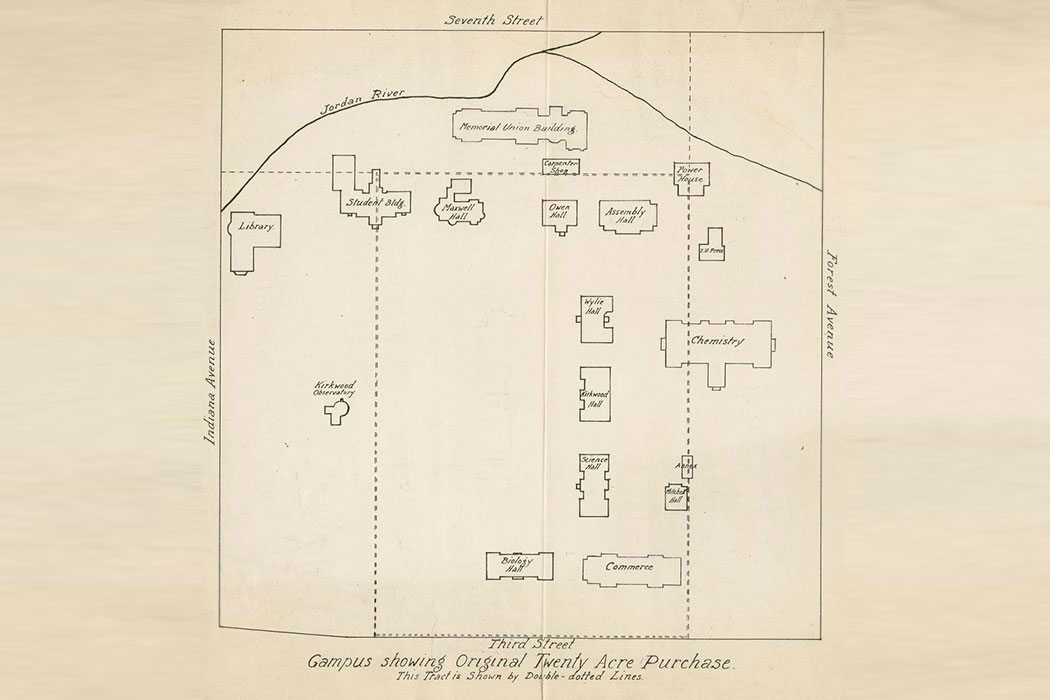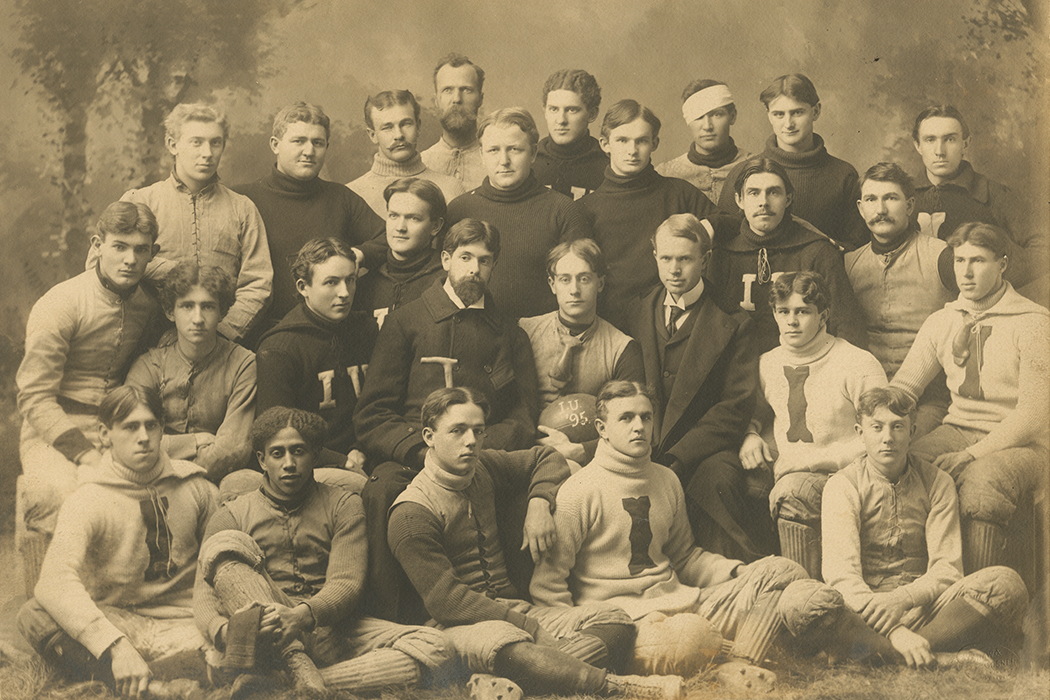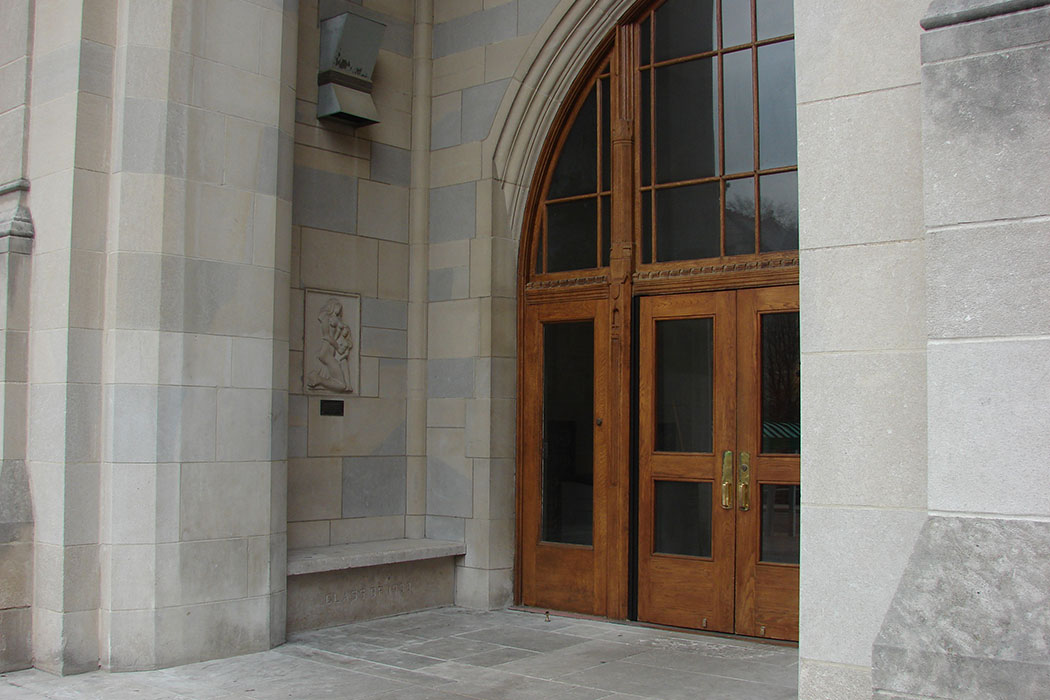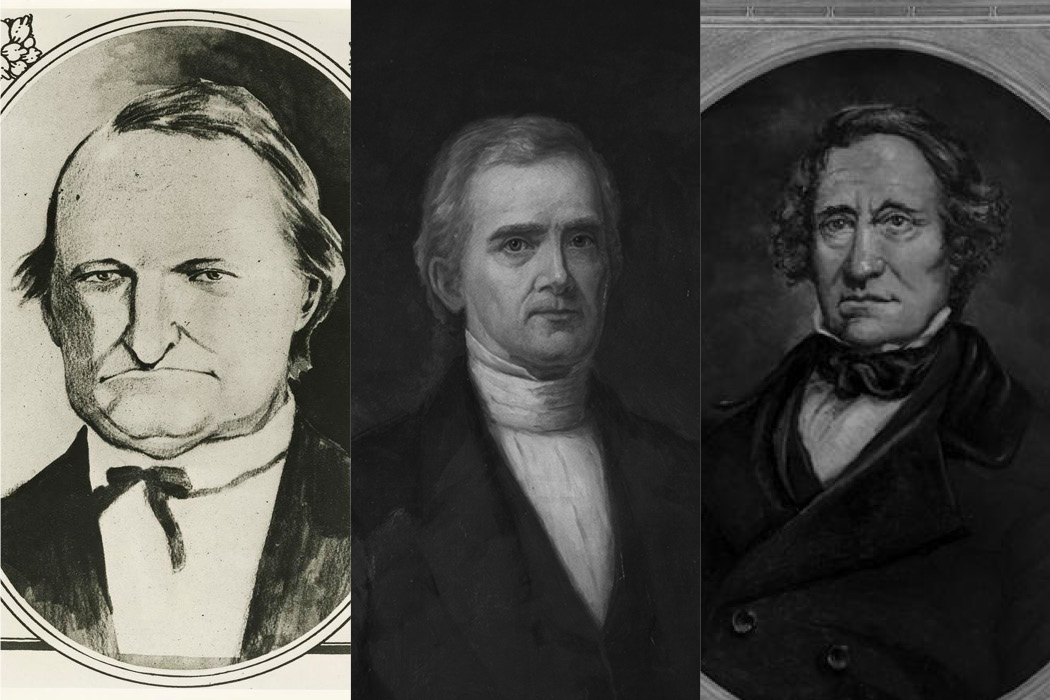True or False? Myths of IU, The Dunn Family

Time and imagination can bury the truth of a person, place, or event under layers of mythology. By excavating facts from the deep sediment of urban legend and storytelling passed from one generation of IU tour guides to another, this series puts IU myths to the historical test.
In this article, you get three myths for the price of one. These three myths are all rooted in one family: the Dunns. The Dunn family owned a mass of land in Bloomington in the 19th century, when IU’s lone campus was located where Seminary Square park is now. In 1883, after a fire destroyed one of the Seminary Square buildings, the Board of Trustees decided to transplant the campus. After some deliberation, the Board bought from Moses Dunn 20 acres of land, known as Dunn’s Woods, which became ground zero of the present-day Bloomington campus. This transaction has since become folkloric.
Legend has it that when the Dunns agreed to sell the land to IU, they set up three stipulations:
- The Dunn family burial plot on the property shall not be moved.
- For every one tree cut down, another must be planted in its place.
- The Sweetheart Tree shall not be cut down or moved.
In a nutshell, all three of these legends are false: the deed for Dunn’s Woods of Feb. 4, 1884, does not include any explicit restrictions on how IU may use the land. But, like most legends, each of these points contains slivers of distorted truth. Let’s break it down.
Dunn Family Plot
Although the deed that granted Dunn’s Woods to IU doesn’t mention a family plot, there is another deed that restricts and preserves a parcel of land on the Bloomington campus exclusively for the Dunns. Twenty-eight years before Moses Dunn signed over the 20 acres to IU, his father, George Dunn Sr., drew up a deed that set the boundaries for a family burial plot.
“In order to secure and perpetuate to the descendants of Eleanor Dunn, Nancy Alexander, and Jane Irvin who be buried within the plat of ground…and to those with whom they intermarry forever a place of private burial where they shall repose together as one family in the long night of death and rise up together as from one bed at the last day,” the deed says.
Because George Dunn’s deed was signed Nov. 21, 1855, only descendants of George Dunn’s mother, Eleanor Dunn, and her two sisters are permitted to be buried there. Before the Dunns were a Bloomington name, Eleanor Dunn and her two sisters served as aides in George Washington’s army during the Revolutionary War. The cemetery where the three revolutionaries are buried is now nicknamed “God’s Acre” and is nestled between the Indiana Memorial Union and Beck Chapel. The land is still owned by the Dunn family, but is maintained by the IU.
Tree for a Tree
“I don’t think I have ever been at a more beautiful university commencement than this. I shall always keep in mind this scene here in the open…here under these great trees, these maples and beeches, that have survived over from the primeval forest.”
—U.S. President Theodore Roosevelt during his June 12, 1918 IU Commencement speech
IU Bloomington has long been known for its woodland oasis, where trees have canopied buildings and sidewalks since the establishment of the Old Crescent. Even if the Dunn deed theory doesn’t check out, it isn’t outlandish, considering IU’s relationship with its campus trees.
“When I was a student, I was told that Herman B Wells [BS’24,MA’27, LLD’62] said when he was president that no trees could ever be cut down,” recalls Vice President Emeritus Terry Clapacs, BA’65, MBA’69, who served the university for 43 years. “When I first began working in this position, I asked [Wells] about that, and he said, ‘I never said that. Of course I wanted us to always be careful with trees; trees are precious.’”
In fact, IU has never had a formal policy requiring the replacement of trees when they are cut down, Clapacs says. Mia Williams, BA’88, university landscape architect, confirmed, saying that there is no formal policy. However, Williams says there is a minimum replacement standard of 3-to-1 that acts as a guideline in the case of construction.
“Trees are so important to us that we treat each case individually,” Williams says.
Tree preservation has been championed by IU’s presidents throughout time. In fact, in 1965, the University erected a bust of Herman B Wells that faces Dunn’s Woods, and during the bust’s unveiling, Wells quipped that the bust had been made with a “special atomic formula” so that “if anyone starts to desecrate any tree on campus a reaction will occur and the bust will frown, or cry, or maybe even speak.”
Sweetheart Tree
One tree in particular has attracted much speculation and folklore: the Sweetheart Tree. The Sweetheart Tree is the American Beech tree that sits at the center of the Chemistry Building courtyard and entranceway. Legend has it that the Dunns issued mandatory protection of the tree because their eldest daughter and her sweetheart carved their initials into the trunk. This set a precedent for other couples to monogram the tree, imbuing it with even more sentimentality. So in the 1980s when IU constructed an addition to the Chemistry Building, the architects and builders had to build around the tree in order to follow the Dunns’ decree.
Although this story is romantic and wistful, the deed to Dunn’s Woods indicates that the Dunns never mandated the protection of the Sweetheart Tree.
So why did IU go to such lengths to keep the Sweetheart Tree during the expansion of the Chemistry Building?
The beech tree has graced the exterior of the Chemistry Building since its initial construction in 1931. Thirty years later, an addition was built onto the original Chemistry Building that had a modern, austere architectural style and the tree was untouched. When it came time to plan another expansion to the Chemistry Building in the 1980s, the challenge for University Facilities, which was headed by Terry Clapacs, and the architects was to create a harmonizing building extension that also complimented its wooded neighbor.
“Removing (the Sweetheart Tree) was never a serious consideration,” Clapacs says. “What we thought about was how to protect it because we had this tradition and all these stories that are attached to it, and alumni like to come back and look at it. And it adds some flavor to the campus.”
Clapacs also notes that it’s no surprise that there’s a myth attached to the Sweetheart Tree.
“Even when I was a student here, which was in the 1960s, there was an awareness of that tree and it had a special meaning to the students on campus. The old library was over in Franklin Hall, so walking from Ballantine to Franklin Hall was something you’d do two or three times a day.”
Although the myths that are rooted in the Dunn deed are historically false, the traditions that have arisen from them are an important part of our heritage and continue to shape the way that people experience IU.

This article originally appeared in the January 2018 issue of 200: The IU Bicentennial Magazine, a special six-issue magazine that highlights Bicentennial activities and shares untold stories from the dynamic history of Indiana University. Visit 200.iu.edu for more Bicentennial information.
Tags from the story
Written By
Kayla McCarthy
Kayla McCarthy is currently a senior at IU, and is a contributor to 200: The IU Bicentennial Magazine.



